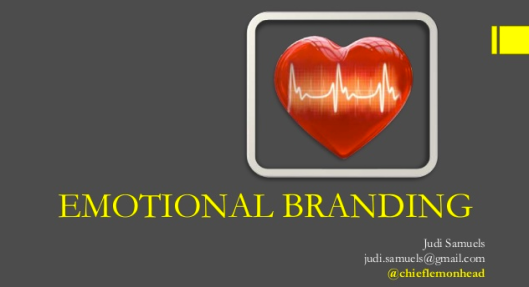Tags
Conferences, Consumer Loyalty, Emotional branding, Humanizing business, Online Revealed, Presentations
Humanizing a brand, unlike personifying a brand, means allowing a brand to literally take on human traits. I’ve been repeating myself in affirming that businesses are run by people and that their consumers are people, so the fact that we reduce our business doings to a set of numbers seems counter intuitive, no?
Presentation given at Online Revealed 2013
You may in fact, be arguing that statement right now… but let’s think this through: ROI, a number; satisfaction index, a number; likelihood to refer, a number; revenue and basket value, numbers. Bottom line, it’s about the bottom line. Now, I’m certainly not disputing the fact – and I never have – that businesses must make money. The very fact that they are in business suggests that they do indeed make money. And don’t be fooled, your consumer is well aware that you make money. So, what I ask of businesses and business people is to accept the fact that making money is a table stake.
You will always need to look at the balance sheet, and you will always need to set goals. You should always continue to optimize your marketing mix, lead generation campaigns and sales efforts. But you must also, and if not more importantly, take stock of the humanity in your business and ensure that it is just as celebrated and adjusted as the numbers.
See, depending on the purchase type – new, repeat, major, minor, luxury, etc. – your consumer is not only looking to buy a thing; today, consumers are looking to become a part of something. Go ahead; roll your eyes! But when you’re done think about the last time you bought a car, a leather coat, that perfect pair of shoes, or those tickets to that show you wanted to see. Convince yourself that it was just because you needed that thing but you know better. There was an emotion behind the purchase: a desire to look a certain way, to have a certain status, or to be included in a certain community. I’m not asking you to shout your emotional vulnerabilities on a rooftop. I’m just asking you to be honest with yourself about the very real fact that emotions drive a lot of your consumer purchase decisions. If your emotions drive you, what do you think drives your consumer? What about your employee?
Emotions are at the center of what makes us human… in short we filter what we are exposed to through our context lens and decide whether we like it or not. We have a range of emotions to choose from. For marketers, this matters because we already know that if someone has a positive experience with your brand, they are more likely to repeat that experience. Now, if you can get a deeper understanding about your audience’s context lens and deliver experiences that tap into their nuanced and deep range of positive emotions, what do you think would happen next?
Emotions drive loyalty. Not the same old “do this, get that” type of loyalty… Emotional loyalty: willingness, on the part of your consumer, not only to repurchase your brand, but also to evangelize and furthermore to defend your brand. Would your consumers defend you? Apple’s consumers would. So would Starbucks’ consumers.
Does it matter? McKinsey and Gallup have each released research results in the past few years showcasing that 21% of the population self-identifies as being brand loyal, and that brands who hold the largest population of brand loyal consumers in a given industry can command an average price premium of 23% over competitors! You tell me if it matters.
How can you allow your brand to be human? Allow it to feel? Allow it to make mistakes and to celebrate successes – openly, just like any human would? How can you create emotional loyalty?


